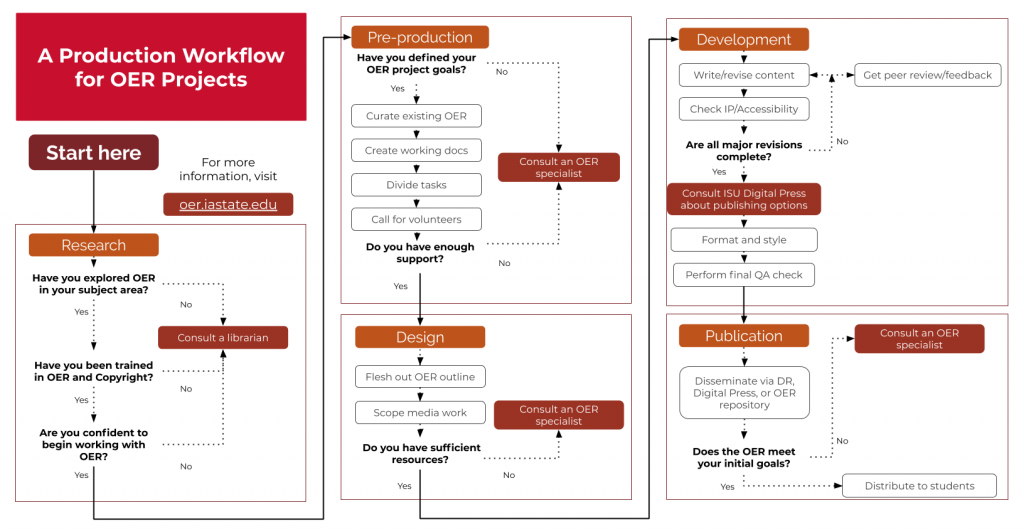10 Authoring OER

OER Workflow Iowa – Google Drawings
Creating or authoring Open Educational Resources (OER) involves several steps, from planning and creating content to licensing and distributing the materials. Here’s a guide to help someone author OER:
Planning and Identifying the Need
- Define your audience: Consider who will be using your OER (e.g., high school students, university professors, adult learners).
- Identify gaps: Determine what specific educational materials are missing or could be improved in your subject area. This could be based on your teaching experience, student feedback, or reviewing existing OER.
- Set clear learning objectives: Ensure the OER content aligns with educational goals or curriculum standards.
Creating the Content
- Decide on the format: OER can take many forms, such as:
- Textbooks
- Lesson plans or course modules
- Videos or animations
- Quizzes or assignments
- Interactive activities or multimedia
- Full courses or lectures
- Use existing OER: You don’t have to start from scratch. Review existing OER materials that you can adapt, remix, or build upon. Look for OER licensed under Creative Commons licenses that allow adaptation.
- Write or develop content: Whether you’re writing a textbook or creating lesson plans, focus on making the content clear, engaging, and accessible for your audience. Use plain language and consider accessibility features (e.g., alt text for images, captioning for videos).
Incorporate Multimedia and Interactivity
- Multimedia: Include videos, infographics, diagrams, or podcasts to enrich your content.
- Interactive elements: Consider using online tools to create quizzes, polls, or simulations to make the OER more engaging.
Ensure Accessibility and Inclusivity
- Make your OER usable for learners with different needs:
- Ensure materials are available in multiple formats (e.g., text, audio, video).
- Use descriptive alt text for images.
- Provide transcripts for audio or video content.
- Use inclusive language and ensure your content is free from bias.
Apply an Open License
- Choose an appropriate open license (e.g., a Creative Commons license) that allows others to freely use, adapt, and share your work.
- CC BY (Creative Commons Attribution) is the most open license, allowing anyone to use and modify your work as long as they give proper credit.
- Other options include CC BY-SA (Attribution-ShareAlike) or CC BY-NC (Attribution-NonCommercial), depending on how much control you want over the use of your material.
- You can select and apply a license at Creative Commons.
Peer Review and Feedback
- Seek input from colleagues or experts in your field to ensure the accuracy and quality of your OER.
- If possible, test the material with students and incorporate their feedback to improve it.
Publishing the OER
- Publish here at Pressbooks! Contact Stacy Scott s.scott@moreheadstate.edu to get started!
- Metadata: Ensure you include proper metadata (author name, title, subject, level, learning objectives) so others can easily find and use your resource.
- Open textbooks can be added to Morehead State University’s institutional repository. Please email s.scott@moreheadstate.edu to have it added or use the following form: Submit OER to institutional repository
Promoting the OER
- Share your OER through social media, educational forums, and with your professional network.
- Encourage others to use, adapt, and remix your material, which is the spirit of OER.
Updating and Maintaining the OER
- Regularly review and update your OER to keep it current. As education standards and technologies change, your material may need revisions.
- Open licensing means others can also help revise and improve the resource over time.
Key Steps Recap:
- Plan the content and audience.
- Create educational materials, ensuring they are accessible.
- License it with an open license (e.g., Creative Commons).
- Publish the OER in an open repository.
- Promote and share the resource with others.
By following these steps, authors can contribute high-quality, openly licensed materials to the growing pool of OER, allowing educators and students worldwide to benefit.
Created by AI, reviewed by a human.
Falldin, M., & Lauritsen, K. (2017, March 28). Authoring open textbooks. Pressbooks. https://pressbooks.pub/authoropen/
Seraphin, S. B., Gerlitz, C., & Mendenhall, R. (2021). The OER starter kit workbook. Rebus Community. https://cuny.manifoldapp.org/read/the-oer-starter-kit-workbook/section/5369e0e3-9899-47bd-a71d-c9370f542ccb
